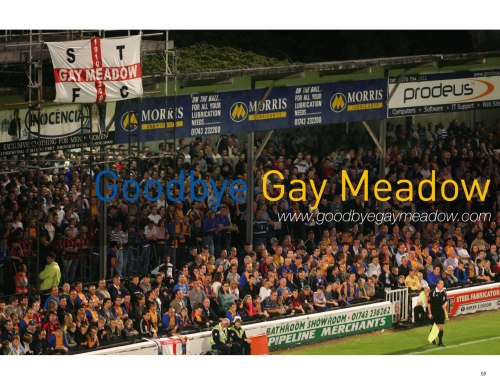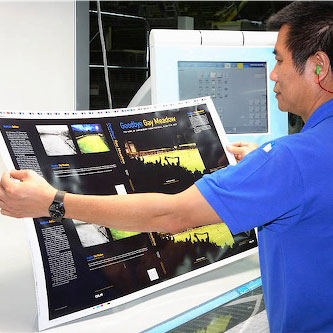Goodbye Gay Meadow was a project undertaken when Shrewsbury Town Football Club decided to leave their home since 1910.
It was my home, my church, my meeting place for so many lifelong friends. My career was forged there. It was there I got through hundreds of rolls of film whilst perfecting manually focussing lenses, which of course is another lost trade to my armoury.
When going to a foreign stadium, everything in front of me is fresh and visually magnetic. Trying to not only capture and record the views from all four sides of Gay Meadow was immensely difficult due to a mega-saturated over familiarity.
That was the first of many hurdles to overcome and to be totally out of my comfort zone.

My first visit to Gay Meadow was at the age of six. I thought that every football ground was surrounded by a line of beautiful trees and a river where a man in a coracle went to collect the ball when it got kicked over the stadium – Let alone a wonderful bricked building in the shape of a college and a view to a medieval castle!
 It is certainly true to say that Gay Meadow was one if not the most picturesque football stadium in the United Kingdom.
It is certainly true to say that Gay Meadow was one if not the most picturesque football stadium in the United Kingdom.

For most of the time, my head is in the clouds, but I really had to think and plan my approach to documenting MY football club home.
When I am doing a FIFA World Cup Final, because my makeup and psychology, I just switch off and run on auto-pilot.
Documenting Gay Meadow was personal. It mattered!
When I am on the London Underground and see strangers reading a newspaper with my picture on it I have no emotion. However upon producing something that my lifelong Shrewsbury Town friends will see, I HAD to do a good job.

Every detail had to be covered by my highly critical eye.
The views from all four corners of the ground were so unique resulting in every fan having a unique backdrop to others situated in other parts of the stadium.

Then there was the quirkiness of it all. The ivy growing in the Gents, the floodlights, the river and the floods, historic turnstiles and the art of the stadium – signs and indeed advertisements which became a part of the furniture.
I had previously documented the mass destruction of other famous grounds from Espanyol in Spain to Southampton so I had previous.
I knew the fabric of the football club would change and I also knew that no one else was going to document and record a lasting reminder for people to look back on in years to come.  Just as it was common for me to open my curtains and see the floodlights, which one day would go, it was a common occurrence for thousands to be walking over the English Bridge in Shrewsbury every time there was a game. Fans would have to change routines and all these happenings would never happen again.
Just as it was common for me to open my curtains and see the floodlights, which one day would go, it was a common occurrence for thousands to be walking over the English Bridge in Shrewsbury every time there was a game. Fans would have to change routines and all these happenings would never happen again. Pictures tell a thousand words as people say, but words that accompanied the photography, helped made the book.
Pictures tell a thousand words as people say, but words that accompanied the photography, helped made the book.

Shrewsbury Town fans contributing amazing words about the stadium. These included hilarious memories about their time in the stadium to poignant personal reminders on how a football ground affects people’s lives.
One fan wrote about being a child and standing with their father and grandad on the terraces, becoming four generations when he became a father and returning on going back to three generations when his grandfather passed away with his father watching the game with tears in his eyes.
I went to a school in Shrewsbury called Meole Brace along with a certain Joe Hart, but I had to almost professionally interview lifelong friends about their school years in the school adjacent to the ground called the Wakeman. There was no messing about, I had to get everything correct.
Then there was the mass of self-educating and researching about the book industry. I heard of crazy stories about publishers printing 250,000 copies to only pulp 100,000 of them to save costs!
High Street shops seemed to operate a mafia type ways of working – if you wanted to sell your book in a certain shop, you HAD to distribute to a certain book distributor who wanted 40-60% of the fee. Even though the said shop was half a mile from my then house, I had to package up and post via their favorite courier to the South of England for them to then deliver it themselves. Negotiation was a big no. It was their way or no way.
The paying public does not case about such matters. They assume if you publish a book, that one can purchase it from a High Street bookstore. I had to weigh up sales over costs and availability.
My aim was to create a coffee table book, a lasting reminder. Print quality was of paramount importance, but this caused problems too. I did not have a clue on how many copied would sell. Everyone I spoke to agreed I could sell 500 or equally 25,000 copies.
Changing the amount of plastic dye on the cover jacket caused the production price to rocket by a thousand pounds if I chose a print run over 20,000! The price of printing the book in the UK to Asia was 800% more. I found a wonderful printer in Singapore. They frequently sent samples to me. I was very happy with the quality, but upon holding different style of paper, from blue-white to gray-white to pure white to many different weights, this made some of the pictures look so different and caused more unexpected headaches.
The price of printing the book in the UK to Asia was 800% more. I found a wonderful printer in Singapore. They frequently sent samples to me. I was very happy with the quality, but upon holding different style of paper, from blue-white to gray-white to pure white to many different weights, this made some of the pictures look so different and caused more unexpected headaches.
The next challenge was to learn how to use Adobe InDesign and importantly understand what the printer required. The book was self-published with the help of expert book designer Jim Lockwood. The changes of inputting colour profiles of the printer to how the files were exported and subsequently looked were immense and vitally important.

Next was the creating the brand of the book. The way it looked, the feel of it. Choosing the front cover and the fonts caused even more big decisions to me made. Eventually, the font DIN was chosen.
Regardless of what was inside the book, this book had to be sold so buyers had to be magnetised and intrigued. Thus, the design of the cover was of a huge importance.
ISBN numbers had to be understood, the book had to be registered. The legal requirements are quite high too.
 I assumed that the layout would be fun, but it became a matter of following rules and keeping a rhythm.
I assumed that the layout would be fun, but it became a matter of following rules and keeping a rhythm.
Composition lines were easy to understand – though this resulted in a half day in a local bookstore when upon looking at other books the penny dropped on what visual tricks could be done to maximise showing off the pictures as best as possible.
When I syndicate images to a publisher, they choose the editorial style, they choose if an image is worthy of the front. Like most photographers, they are brilliant at choosing other photographers work for competitions and portfolios but useless at assessing their work.
At this point, I have to thank Michael Regan from Getty Images who encouraged me to make some of the pictures smaller and some of the smaller pictures bigger!
The deciding in where to place 256 images was very difficult. More things to learn!
Musicians tell me that adding a different beat dramatically changes a piece of music. The same was with the layout of the pictures. Putting one picture on page ten or page thirty, again changed everything.
I always say that is like composing a complex opera.
The financing of it was a very important hurdle to over come.
I think my sheer enthusiasm at Lloyds Bank resulted in them lending me a very large five figure sum to pay for the printing. Thankfully they believed in the project.
 Sending images of a goal from a final of a football match is just an everyday occurrence, but sending the packaged files to Singapore via FTP was an exciting moment. When the last file had finished sending, it was all over to the point there was a void in my life! But I did not have time to reflect. I then had to look at marketing it.
Sending images of a goal from a final of a football match is just an everyday occurrence, but sending the packaged files to Singapore via FTP was an exciting moment. When the last file had finished sending, it was all over to the point there was a void in my life! But I did not have time to reflect. I then had to look at marketing it.

The printers were amazing at sending me images of the book being produced. They really cared about producing the book and took immense pride in its’ creation. This helped in the marketing in creating a buzz that the book was being produced.
Finally, the day came when the book was shipped. A three week wait for a container to reach Southampton Docks from far East Asia went very quick.
Having presents on Christmas Day is exciting. Having a 44-tonne truck deliver thousands of books creates a lot of work and is anything but exciting.
I don’t think I actually sat down and looked at the book properly. Selling the book was the next challenge with the sole aim of finishing the bank loan.
The project was a labour of love and certainly not a way to finance my lifestyle!
To cut a long story, the loan was eventually finished. It was in the same week the book won the Best Illustrated Title in the British Sports Book Awards.
Finally the demolition of the stadium, a project that has had its first public airing on the website www.goodbyegaymeadow.com
That was very hard to document. Photographing news jobs of car crashes, fires is child’s play to most photojournalists until it is someone you know. Photographing the demolition and being there during the mass destruction taught me lots of things too! But that’s another story and perhaps another blog for the future!

The next phase is to make an e-book of Goodbye Gay Meadow. Again I have more questions than answers at the moment.
Through writing this blog, I have become aware of an Australian author called Ana. I follow her blog and after going through it myself, feel everything she does. http://anaspoke.com/
GOODBYE GAY MEADOW is available from Amazon http://www.amazon.co.uk/dp/0955651808




Well done Matt. Very impressive
Maybe then , Shrewsbury IS the home of football as you allude to.
You should mention Shrewsbury School -the school has an 1856 copy of the Cambridge rules of football, the oldest surviving copy of the Laws of the Game, predating the 1863 rules of the FA.